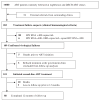Second-line treatment in the Malawi antiretroviral programme: high early mortality, but good outcomes in survivors, despite extensive drug resistance at baseline
- PMID: 20345885
- PMCID: PMC4833877
- DOI: 10.1111/j.1468-1293.2010.00825.x
Second-line treatment in the Malawi antiretroviral programme: high early mortality, but good outcomes in survivors, despite extensive drug resistance at baseline
Abstract
Objectives: The Malawi antiretroviral therapy (ART) programme uses the public health approach to identify ART failure. Advanced disease progression may occur before switching to second-line ART. We report outcomes for patients evaluated and initiated on second-line treatment in Malawi.
Methods: Patients meeting Malawi immunological or clinical criteria for ART failure in two large urban ART clinics were evaluated for virological failure (viral load >400 HIV-1 RNA copies/mL) and, if failure was confirmed, initiated on second-line ART (zidovudine/lamivudine/tenofovir/lopinavir/ritonavir). Patients were seen monthly and laboratory evaluations were performed quarterly and as needed. We performed logistic regression modelling to identify factors associated with mortality, mortality or new HIV illnesses, and virological suppression at 12 months.
Results: Of the 109 patients with confirmed virological failure, five patients died prior to initiation, three declined switching and 101 patients initiated second-line treatment. Over 12 months, 10 additional patients died, 34 patients experienced 45 HIV-related events, and 19 patients experienced grade 3 or 4 toxicities. Among survivors, 85.2% had HIV-1 RNA<400 copies/mL at 12 months. While power to distinguish differences was limited, response rates were similar regardless of baseline resistance level. The median CD4 count increase was 142 cells/microL. World Health Organization clinical failure at baseline [odds ratio (OR) 3.47; 95% confidence interval (CI) 1.14-10.59] and body mass index <18.5 (OR 4.43; 95% CI 1.15-17.12) were risk factors for death. Baseline CD4 count <50 cells/microL was associated with increased risk for death or morbidity at 12 months (OR 2.57; 95% CI 1.01-6.52).
Conclusions: Second-line treatment in Malawi was associated with substantial mortality, morbidity and toxicity but, among survivors, virological outcomes were favourable.
Figures



References
-
- , editor. World Health Organization. Antiretroviral Therapy for HIV Infection in Adults and Adolescents in Resource-Limited Settings: Toward Universal Access. Recommendations for a Public Health Approach. Geneva: World Health Organization; 2006. p. 128.
-
- , editor. Ministry of Health Malawi. Treatment of AIDS: Guidelines for the Use of Antiretroviral Therapy in Malawi. 2 Lilongwe: Malawi Ministry of Health; 2006. p. 155.
-
- Department of HIV and AIDS Ministry of Health; Department of HIV and AIDS MoH, editor. Quarterly Report of the Antiretroviral Treatment Programme in Malawi with Results up to 31st December 2008. Lilongwe: Malawi Ministry of Health; 2008.
-
- Ministry of Health Malawi. Treatment of AIDS: Guidelines for the Use of Antiretroviral Therapy in Malawi. 3. Lilongwe: Malawi Ministry of Health; 2008.
-
- Eron JJ, Jr, Bartlett JA, Santana JL, et al. Persistent antiretroviral activity of nucleoside analogues after prolonged zidovudine and lamivudine therapy as demonstrated by rapid loss of activity after discontinuation. J Acquir Immune Defic Syndr. 2004;37:1581–1583. - PubMed
Publication types
MeSH terms
Substances
Grants and funding
LinkOut - more resources
Full Text Sources
Medical
Research Materials

